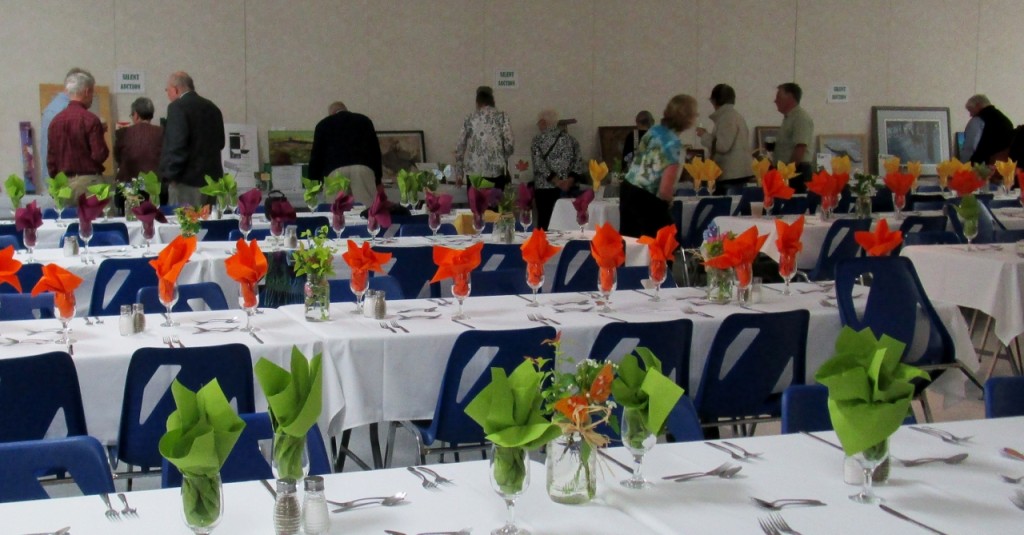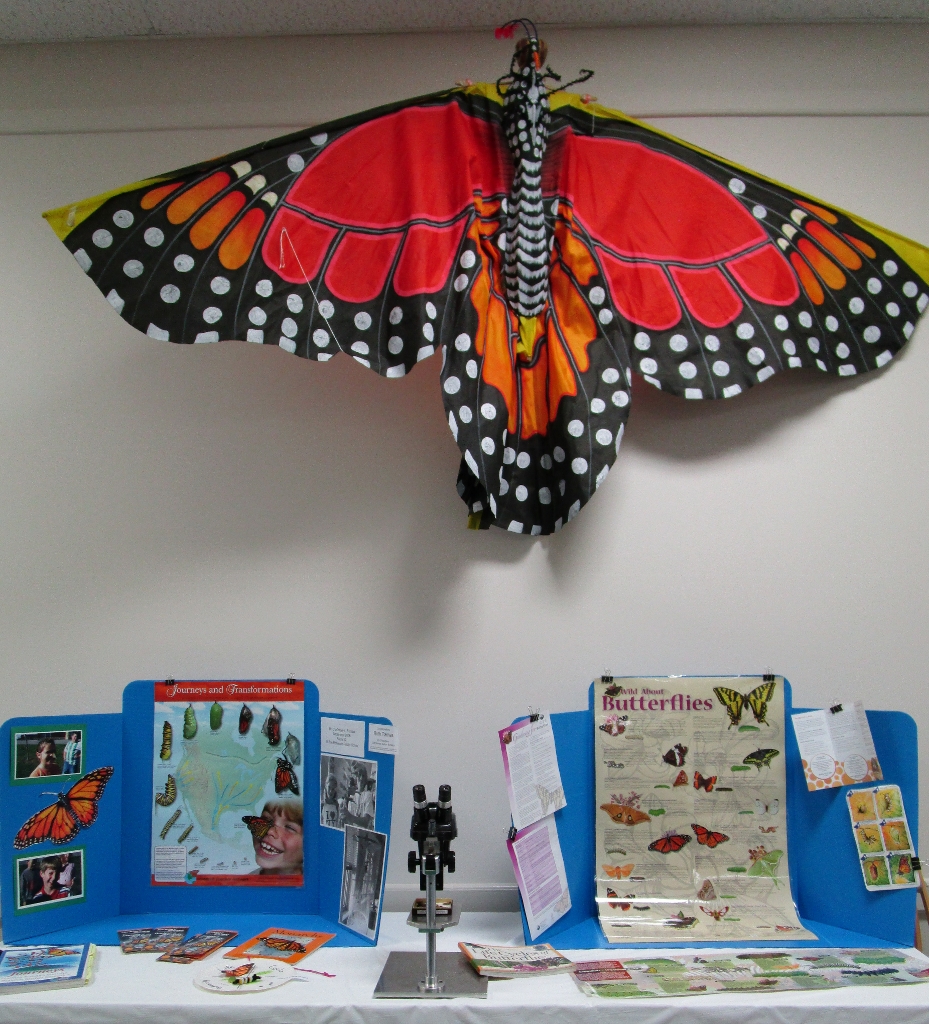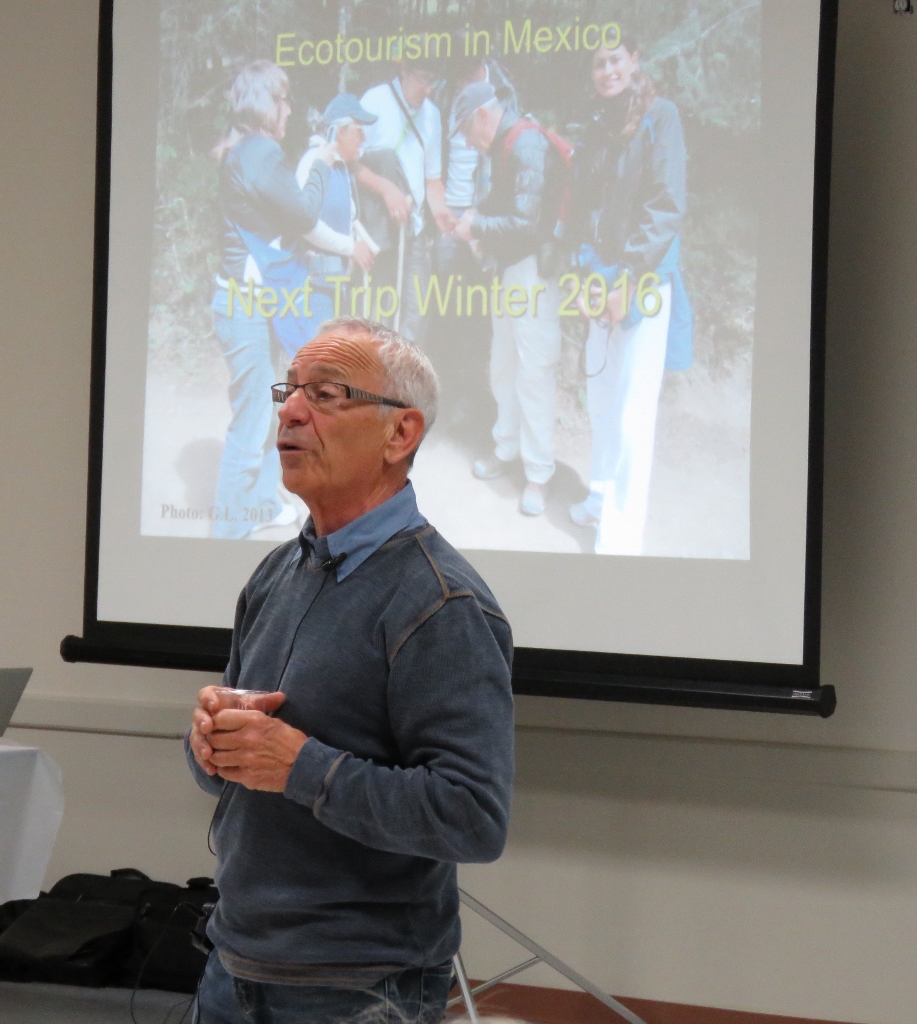A monarch of the insect variety ruled at the Mississippi Valley Field Naturalists’ (MVFN) 2015 Spring Gathering at the Almonte Civitan Community Hall on May 21st. Over 130 people gathered for the 6th annual dinner, awards ceremony and presentation, Mysteries of the Monarch Butterfly.
The Almonte Civitan was a flourish of butterflies, spring wildflowers and brilliant ‘butterfly & spring’ colors of green, orange and yellow sprouting from sparkling glasses, thanks to the design inspiration of MVFN members Lucy and Neil Carleton. An interesting educational display on butterflies was created by Neil Carleton. The large group mingled and met with friends as much interest and excitement was generated by the Burnt Lands Alvar Silent Auction fundraiser, organized by Bob and Cheryl Smith and the Alvar Campaign committee. Amongst the items: a basket loaded with everything needed to create a monarch butterfly garden with a young child! Thanks to the generosity of club members and local community gardeners, birders, artists, business owners, and of course successful bidders, the Burnt Lands Alvar fundraiser was a resounding success!



Following a delicious dinner by Civitan volunteers, awards presentations began with MVFN Past President Ken Allison as Master of Ceremonies. Friend and Mississippi Madawaska Land Trust (MMLT) co-board member, Mary Vandenhoff, presented an MVFN Champion for Nature award to Howard Clifford, MMLT President and co-steward of the ‘Cliffland’ nature preserve and Blueberry Mountain. Almonte and District High School student Ruth Tamas was awarded the 2015 Cliff Bennett Nature Bursary Award, presented by Bursary Chair Mike Macpherson. Dedicated to a sustainable future, Tamas plans to study Environmental Engineering. An exciting announcement also took place when Barbara Chouinard of the Ottawa Field Naturalists Club presented a $5000 cheque for MVFN’s Burnt Lands Alvar Campaign.


Guest speaker Jean Lauriault (Canadian Museum of Nature Associate) was enthusiastically introduced by Mary and Howard Robinson who were part of MVFN’s first ever international outing, led by Jean, to the overwintering grounds of the Monarch butterfly in Mexico.
In an inspired presentation, Jean told the story of the Monarch, the only butterfly to migrate; with the eastern North American ones migrating to Mexico and back each year. Now they are on their way back —the ‘great grandbutterfly’ descendants of the ones that left here last fall. Almost here now— out of Mexico they follow spring weather and healthy milkweeds through the Southern U.S. (where native milkweeds grow in early spring but then die off), progressing northwards to our area. Once here several generations lasting only a few weeks are born, but in August those born will live for ~9 months. During that time the same individuals seen here will fly to the mountains of Mexico using staging grounds such as Point Pelee to cross large lakes, live the winter in Mexico along with millions of others in very dense clusters in trees, and finally travel north out of Mexico, then breed and die. Still a mystery: how they manage the journey; is it an inherited behavior triggered by circadian clock, or is navigation via the sun, magnetic fields, etc.? Originally a tropical species, it is thought that 10,000 years ago the species came north as glaciers melted and they now must migrate. Also a mystery: why one location in Mexico, El Rosaria, is the choice overwintering ground, chosen first over others.

Between Monarchs and milkweeds, a delicate relationship exists. Eggs must be laid on only certain milkweed species; the only plants the caterpillar can eat. The adult chooses plants with enough, but not too much, toxic cardenolides (which is sequestered to make the Monarch toxic to prey); plants are evaluated carefully using receptors on the legs and antennae. Loss of wildflower habitat (nectar species for the adults) in the U.S. where millions of hectares are planted with corn and soybean for biofuels, pesticides such as the neonicotinoids, loss of the critical milkweed hosts, threats to the integrity of overwintering grounds, and climate change all threaten the Monarch. Efforts in the Southern U.S. to plant certain milkweed species are now known to backfire because unlike native milkweeds, some species do not die off and the population’s movement north and its subsequent migration (which keeps the population healthy and lowers diseases) may not take place. Protecting milkweed and preserving pesticide-free wildlife space here helps the butterfly.
Jean was thanked by former MVFN President Joyce Clinton and the evening wrapped up with door prizes and hidden chair-prizes of mixed milkweed seeds to be planted as food to help out the larvae of our favorite butterfly!






